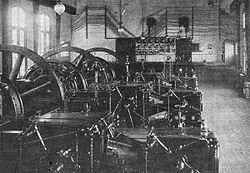Rotary converter plant

A rotary converter plant is a facility at which one form of electricity is converted into another form of electricity by using a combination of an electric motor and an electric generator. The installed combinations of motors and generators at a plant determine the possible type(s) of conversion. Such facilities also allow the setting of voltages and frequencies, if appropriate equipment is installed. Rotary converter plants were commonplace in railway electrification before the invention of mercury arc rectifiers in the 1920s.
At each facility, power from an AC power grid was converted to DC to feed into an overhead line or a third rail of a railway. Rotary converter plants were also used for coupling power grids of different frequencies and operation modes. The former Neuhof Substation was an example of the latter. Former machinery transmitters like the Alexanderson alternator were, strictly speaking, rotary converter plants.
In spite of modern power semiconductor technology, rotary converters are still common for feeding railway systems with AC of a different frequency from that of the main electricity grid. In Europe, this would typically be for 15 kV AC railway electrification.
See also
- Traction current converter plant
- Rotary converter
- Motor–generator
- Static inverter plant
- Lyon-Moutiers DC transmission scheme